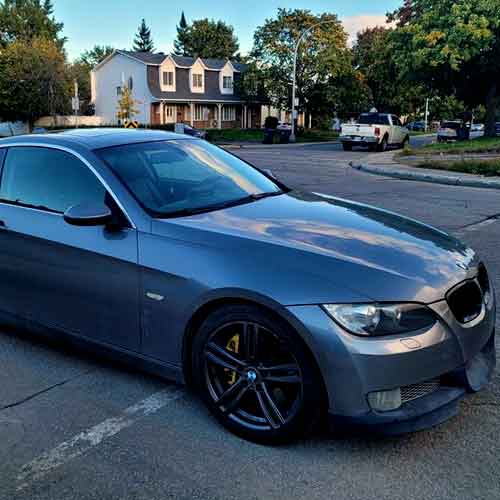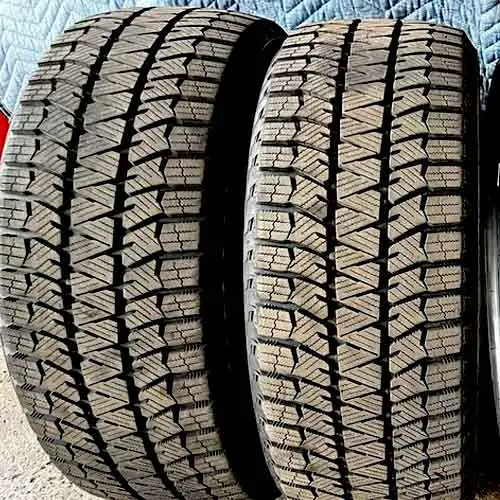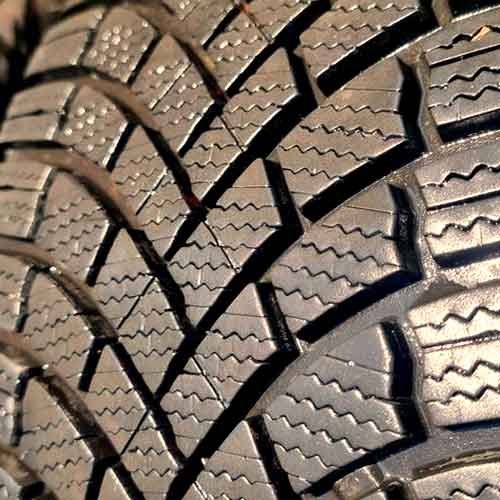Stepping into the frosty fray is the Bridgestone Blizzak LM005, known for its exceptional ride comfort, up against the Bridgestone Blizzak WS90, famous for its superior traction. Let’s see which of these contenders stand tall, when winter winds whip?

Table of Contents
Tire Sizes
The Bridgestone Blizzak WS90 comes in 52 total sizes in 15 to 19 inches (wheels) with following specs.
- Speed ratings: T or H.
- Load ratings: SL or XL.
- Tread depth: 11 or 12/32″.
- Weight: 17 to 29 lbs.
- Tread warranty: None.
On the other side, the Bridgestone Blizzak LM005 comes in just 18 sizes in 18 to 20 inches rims, with following specs.
- Speed ratings: H and V.
- Load ratings: XL only.
- Tread depth: 8 to 11/32″.
- Weight: 24 to 36 lbs.
- Tread warranty: None.
Tread Appearance
The Bridgestone Blizzak WS90 distinguishes itself with a sturdy and intricately engineered directional tread pattern. Allow me to explore its complex features in depth.

So, upon first glance, the tread showcases 3 distinct ribs, and here the central one shows up with a continuous running design, meaning there aren’t any proper lugs formations there.
So this rib comes with interesting attributes, besides carrying a lot of siping, like any other winter tire.
It includes lateral slits that progressively widen as they reach the edges, merging with V-shaped outer notches.
(These V shaped notches basically serve as dual-facing biters, augmenting traction).
The two additional ribs are home to the shoulder lugs. These lugs, although seemingly divided, are not completely so, given the limited depth of the slits. So they don’t split up the blocks and act as in-groove biters (just as seen on the middle rib).
Moreover, these ribs house biters that face laterally, (see how their notches are facing towards the central rib).
On the other hand, Bridgestone Blizzak LM005 also features a directional design with a total of 6 ribs.

The central pair of ribs constitute squared-off blocks that interlock with each other. These lugs exhibit sharp edges accompanied by wave-like siping.
The outer ribs maintain a squared-off structure as well, but they host larger, rectangular-shaped lugs, similarly endowed with wave-like sipes.
All these lugs are longitudinally interconnected, thereby enhancing the tire’s directional and lateral grip and stability.
The shoulder lugs are the most prominent on the tread, or to be more precise, the most elongated.
Although these lugs bear similar sharp sides and wave-like sipes, they also feature lateral slits that significantly contribute to handling, as we’ll discuss in the following sections.
Of course, these lugs are spaced apart laterally, lending the tire an additional feature of self-cleaning on the tread.
Fuel Economy
The fuel efficiency of a tire is essentially related to its traction and overall weight, areas where the Bridgestone Blizzak LM005 could use a little polishing.
The tire’s increased weight and broader tread voids lead to more lug flexing when cornering, braking, or accelerating.
And with greater weight being divided on a smaller surface area, each of its lug bears more pressure on itself, leading of extra expenditure of overall energy.
This flexing, or bending of the lugs, ends up consuming additional energy.
On the flip side, the Bridgestone Blizzak, equipped with longitudinally aligned ribs and a more streamlined design, produces lesser rolling resistance values.
This is another way of saying, its lugs aren’t forced to rub against the road with as much force. Its compact tread structure focuses energy on moving the entire tire rather than bending individual blocks, leading to better energy efficiency.
By the way, this is also the reason, why the overall tread life of this tire is better too.
So overall, to summarize in a line, the Blizzak LM005 wear faster and shows up with greater miles per gallon.
Ice Performance
In icy conditions, the Bridgestone Blizzak WS90 confidently asserts its superiority, with an average of 7 feet shorter braking distance compared to its counterpart.
And, in a similar manner, the tire is also slightly faster, seen in the acceleration tests.
So why the Blizzak LM005 is lacking here?
Well this is because the tire is marked by larger tread voids and fewer notches, seems less equipped for icy conditions. Its central tread area, critical for braking, struggles to grip packed ice due to the tire’s wider lateral tread voids.
And the tire’s lack of multi-angled siping further undermines its performance. This shortfall is also seen in handling, where fewer notches lead to slower handling times.
On the other side, the Bridgestone Blizzak comes out superior wit its detailed biters spread throughout the tread.
The tire’s central rib, for example is featured/equipped with a range of slanted incisions, V-shaped notches facing both lateral directions, and plenty of siping.
And all of these are contributing to the tire’s excellent ice-biting abilities.
Furthermore, the tire’s unique dual-angle design further enhances grip and leads to more effective braking and handling.
Dry Traction
Dry grip is about the degree of rubber contact with the ground, with directional grip and lateral traction playing vital roles. So let me talk about these two one after another.
Directional Grip
The effectiveness of the directional grip is all about the central area of the tread. This is because as the tire rolls straight, for example on highways, the central section is where most of the weight (the tire carries) gets concentrated.
And Blizzak with longitudinal rib there offer superior lug to road connectivity resulting in shorter braking distances compared to its counterpart.
(Braking distance is the direct measure of directional grip, for those of you, who don’t know).
On the other side, with directional pattern having wider lateral tread voids, the longitudinal movement of the blocks is hindered a little bit, and so you get slower braking times.
Handling
Handling is influenced by the tire’s shoulder areas and the overall weight.
As the tire corners, its weight moves towards the edges of the tread (or shoulders), and the quality of their contact with the ground becomes crucial.
Having said that, here, the Bridgestone Blizzak LM005, with its wider grooves, doesn’t quite match the performance seen on its counterpart.
Moreover, the tire’s extra also further hampers the overall performance.
This added weight leads to increased lug movement as the tire tackles corners, subsequently weakening steering feedback.
So overall, the Bridgestone Blizzak WS90 is taking the lead.
Wet Traction
Wet traction is chiefly influenced by two factors: the design of the tread and the rubber compound used in the tire. These components, in turn, control the tire’s grip on wet surfaces and its resistance to hydroplaning.
Let’s examine each aspect.
Wet Grip
Even though both tires come armed with ample siping and flexible tread rubber, the Bridgestone Blizzak WS90 holds an advantage in grip, showing up with less overall slippage on corners.
The tire basically employs a dual siping design, featuring a dense network of rectilinear and interlocking slits, which are also angled. So you get a grip from all sides.
On the other side, the Bridgestone Blizzak LM005, equipped only with laterally oriented sipes, falls a bit short in delivering comprehensive traction, leading to extended wet braking distances and handling times.
So overall, wet grip is better on Blizzak.
Hydroplaning
Hydroplaning occurs when water prevents the tire’s tread from making proper contact with the road, causing the tire to skim over the water and losing all traction – a serious concern.
And here, among the two tires, the Bridgestone Blizzak LM005 excels with its wider grooves.
Those grooves combined with swooping arms disperse water off the tread faster, and facilitate higher average speeds without hydroplaning, in both straight and curved aquaplaning tests.
In contrast, the Blizzak WS90 falls behind with its longitudinal rib, which doesn’t allow, or you can say restricts for efficient sideways water displacement, compared to its competitor.
So the LM005 takes the lead here.
Fluffy Snow Performance
In a snowy backdrop, both tires exhibit their skills with laudable performances. But if you have to pick one here, I would go with the Bridgestone Blizzak LM005, particularly when it comes to fluffier snow terrains.
And this superior traction is all due to its tread design.
The tire carries a slightly more aggressive tread pattern, with spaced apart lugs that reach out to the snowy surface.
These tread blocks are then able to establish snow-to-snow contact, as they effectively pick up and hold the fluffy snow particles within their interlocking grooves and snow-vices.
This process forms a layer of ensnared snow, which helps the tread maintain ground contact through this snowy buffer. As snow bonds better with itself than with rubber, generating enhanced friction.
On the other hand, the Bridgestone Blizzak takes a more minimalist approach to snow, featuring a relatively more closed up design with a continuous running rib at the center and lacking the interlocking groove structure.
This leads to its tread being less eager in gathering snow, hence giving its competitor the advantage.
So, the Blizzak LM005 comes out better on snowy roads.
Summing Up
The Bridgestone Blizzak LM005 shines in snowy conditions with its unique tread design and larger number of tread voids, delivering an impressive snow grip and clearance capability.
However, when it comes to icy terrains, the Bridgestone Blizzak WS90 takes the lead. This is thanks to its array of intricate biting edges, slanted incisions, and multi-angled sipes, which enhance overall traction and handling.
And these biters also helps the tire to demonstrate superior grip on wet roads.
And yes, sames the case when we look at dry traction, fuel economy and tread life.